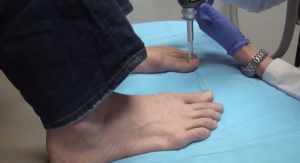 Toenails afflicted with toenail fungus are not pretty. They can be unsightly in many ways. Toenail fungus makes toenails dark, brittle, thick, yellow, and cloudy.
Toenails afflicted with toenail fungus are not pretty. They can be unsightly in many ways. Toenail fungus makes toenails dark, brittle, thick, yellow, and cloudy.
As many as 10 to 14 % of all men and women suffer from nail infections. It’s caused by the fungus that loves to live under our toenails.
Many suffer in silence and feel too ashamed to go barefoot, not wanting to display their bare feet so everyone can see their ugly nails.
What Causes Toenail Fungus?
The toenail fungus grows inside the nail plate on its underside. It’s also embedded in the nail bed, underneath the nail, called distal subungual onychomycosis.
It is typically caused by a dermatophyte called Trichophton rubrum. Dermatophytes are pathogenic fungi that grow on skin, mucous membranes, hair strands, skin, nails and other parts of the body. They cause ringworm, infections and other diseases. Effective treatment is difficult, because it is underneath the nail. It’s difficult to reach.
Where Do You Catch It and How Do You Treat It?
Ointments and creams are ineffective because the infection is under the nail, where creams don’t penetrate.
Oral medicine alternatives provide some small level of relief. A small percentage of patients carry a risk of side effects and might require periodic testing of liver enzymes.
Nail infections usually originate in moist, warm environments. This may mean gym locker rooms, hotel bathrooms, and around swimming pools.
Many people with this problem are not comfortable going bare foot in public. Women whose toenails are darkened and discolored don’t want to wear sandals and open toe shoes.
Yet wearing closed shoes creates a warm climate that continues to stimulate the growth of the fungus.
What is the Most Effective Treatment?
Today a new treatment is available for ridding afflicted feet of their toenail fungus. It is instantly effective and has excellent long-term treatment results. It’s the best solution, because it is completely safe and painless. This highly effective method is Laser treatment.
Pulses of a laser’s high power energy travel in just a few billionths of a second through a toe’s nail plate into the nail bed and growth area. As the laser energy passes through, it instantaneously kills the fungus. The patient may feel warming or pressure or hear a “snapping” sound. That is completely harmless and you will feel no pain whatsoever.
No change can be seen after the procedure. As the toenails begin to grow out over the next three to six months, however, the nail will begin to grow clear and free of fungus.
How Do You Keep Nail Infections From Returning?
The nails grow fairly slowly. But within six months to a year, a clean nail will replace the old, fungus-tainted one. This is if the patient has been faithful and careful with aftercare of their feet.
One of the most critical factors to success is the patient’s strict and careful adherence to aftercare. The rules are simple and easy to follow:
• Wash feet and toes every day. Dry them completely afterward. Pay special attention to drying between your toes.
• Bleach all your existing socks. You may choose to just buy all new ones. Do not put your foot into a sock that might be already infected.
• Keep the inside of all your shoes dry. Do not put on wet shoes. SteriShoe is a device that uses ultraviolet light to sterilize your shoes by shining its light into them. Use it for at least 45 minutes. Leave it on overnight if you like.
• Keep the inside of your shoes free of fungus. Use an antifungal powder or spray to inhibit its growth in your shoes. Try Lamisil or Lotrimin.
• Keep toenails short. Trim them straight across.
• Boil your toenail clippers or clean them with a diluted bleach solution to remove any fungus.
• Wear flip flops, sandals or shower clogs in public places with wet floors: hotel bathrooms, pools, locker rooms and spas.
• Wear shoes that are not too tight, made from a breathable material.
• Apply an antifungal cream to your toes every day.
Apply it:
1) Between your toes
2) Around your nails
3) On the bottom and side of your feet
• Use an antifungal cream with one of these active ingredients:
1) Miconazole 1%
2) Tolnaftat 1%
3) Clotrimazole 1%
4) Terbinafine 1%
5) Butenafine 1%
You’re now free to go to the beach barefoot and feel the sand between your toes. Wearing sandals can feel normal again. Laser treatment makes all the difference.


